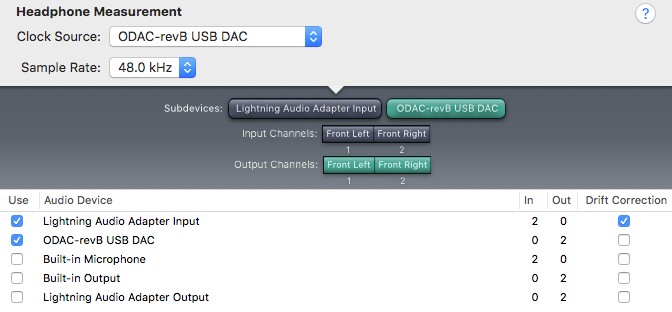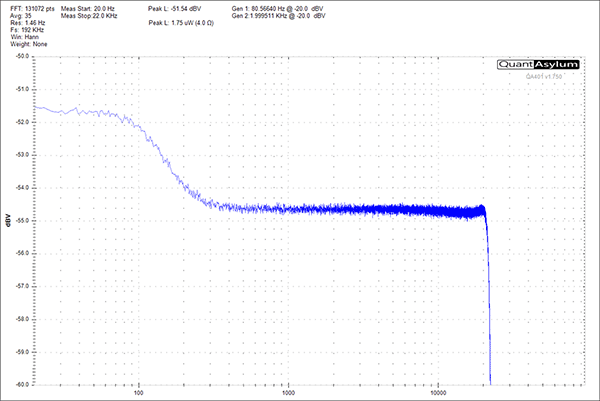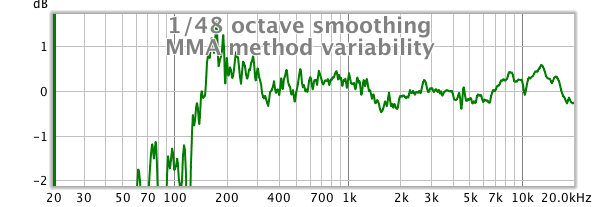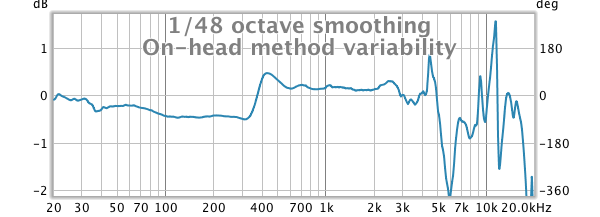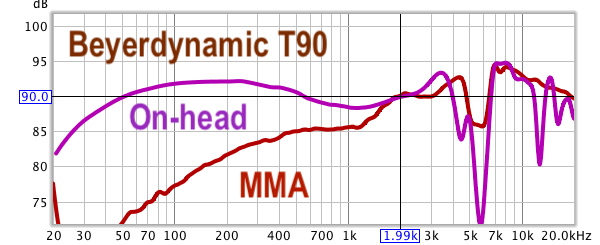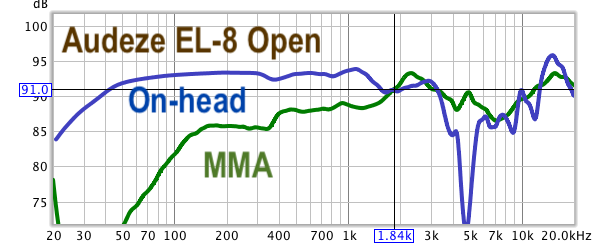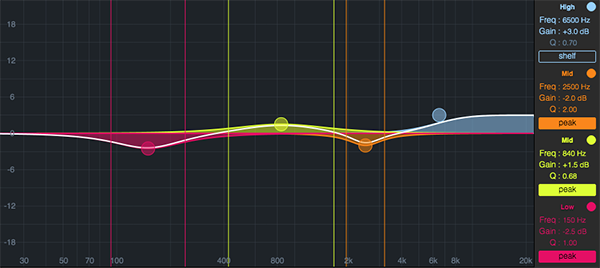Mikhail Naganov
DIY Headphone Equalization
Motivation
Back in time I already experimented with commercial packages for headphone equalization: Morphit by Toneboosters and Reference by Sonarworks. They offer means for correcting the frequency response of selected models of headphones in order to bring the sound closer to either a “reference” target curve or to the sound of some other model of headphones.
Although I still own Morphit I decided to try to devise my own way for headphone equalization. I had the following reasons for this:
-
Although the range of headphone models measured by Toneboosters is quite wide, some of the models I do use: Audeze EL-8 Closed and Open are missing.
-
I intend to use parametric equalizers with limited number of filters available—the equalizer built into MOTU AVB card. I also want to avoid using computers to save myself from the noise of their fans.
-
I wanted to be sure that I apply correction that is relevant to my pair of headphones and to my head. Sonarworks emphasize that there are variations between different pairs of the same model and offers a service to measure your pair, or to sell you a pair of headphones which they have measured on their rig. I would also add that the low end performance of over-ear cans would differ depending on the state of the pads and the shape of the head of the person wearing them.
Thus my plan was to perform my own measurements of the headphones I have and try to bring their sound closer to each other. The practical task I had at hand was to bring the sound of Beyerdynamic T90 and Shure SRH1540 to the sound of Audeze EL-8 I mentioned above. Why to do that? One word—comfort. Let’s compare how much do weight the headphones I own (with cable):
| Model | Weight, grams |
|---|---|
| Audeze EL-8 Closed | 576 |
| Audeze EL-8 Open | 533 |
| Beyerdynamic T90 | 394 |
| Shure SRH1540 | 331 |
| Massdrop 6XX | 317 |
| AKG K240 Studio | 290 |
Although I really love the sound of EL-8 (both variants) their weight is killing me! So my plan was to equalize T90 to sound like the open model and SRH1540 to sound like the closed model. I chose T90 and Shure because their sound feels as “spacious” as in EL-8s, and it’s only their tuning that feels wrong to me: T90 have too much highs, and it’s unnatural and fatiguing, while SRH1540 have a very pronounced V-shaped tuning which I wanted to “flatten”.
Measurement Methods
I used two methods I had previously mentioned in this post: moving microphone averaging (MMA) and on-head measurement using Sennheiser Ambeo Headset. Since the time I’ve made that post I’ve got a couple of updates on them.
Clock Drift with Ambeo Headset
One problem I had with Ambeo Headset is that due to lack of external synchronization use of Ambeo’s ADC for input and an external DAC for output resulted in clock drift which creates a spectral shift when doing long (lasting several seconds) sweep measurements.
I have partially solved this problem by using the feature of Mac OS X audio system called “Aggregate Device”. It allows combining two or more digital audio devices into a single one, and what’s important, takes care of synchronizing their clocks:
This actually fixes the problem with shift of the measured amplitude across spectrum. However, because the drift correction only happens at certain periods, there is still phase shift occuring, especially at high frequencies. Due to this care must be taken when averaging multiple measurements.
MMA and Ambeo On-Head Methods Accuracy
Recall that I tried using the MMA method for reverse engineering the equalization applied by Audeze Cipher Cable for EL-8. Recently I cross-checked these measurements by performing an electrical measurement of this cable into a dummy load. Here is the FR graph acquired by QA401:
It confirms that there is a bass boost, but no other modifications, whereas my MMA measurements were also showing a “scoop” at middle frequencies. So turns out that scoop is a measurement error.
I decided to figure out the accuracy and usable range of both methods by doing several measurements in a row, averaging the result, then repeating the same process and comparing the averages. For the MMA method I came up with the following graph:
As we can see, the usable range is from 200 Hz and the variance is within +/- 0.5 dB. While on-head measurement using Ambeo headset gives the following:
So, the usable range is up to 4 kHz with the same variance. That means, the range from 200 Hz to 4 kHz can be used for judicious merging of the curves. Note that the resulting curve can’t be compared with measurements obtained using standard headphone rigs. However, it can be used for comparing the tuning of various on-ear headphones and deriving equalization between them.
Note that even measurements done using different “standardized” head and torso simulators still can’t be compared directly, as it can be seen from the past exchanges between Tyll Hertsens (ex-Innerfidelity) and Head-Fi, and Audeze.
Also note that before averaging the measurements done using Ambeo Headset I had to convert them to minimum phase first, because the clock drift I mentioned above produces skewed phase:
Thus we can only average the magnitude data. But that’s OK considering that the MMA method, being a single channel measurement also provides magnitude data only.
The Equalization Process
This is the process I used:
-
Obtain an averaged measurement of the headphones’ left driver from 5 MMA measurements. I was performing these measurements by waving slowly the headphone earcup playing pink noise in front of the Beyerdynamic MM-1 microphone while capturing RTA 1/48 octave measurements in REW with infinite aveaging until I’ve reached 100 averages.
-
Obtain an averaged measurement of the same driver from 5 on-head reseatings, this time using a 1M measurement sweep from the headphone into Sennheiser Ambeo Headset microphone.
-
Merge the averaged measurements somewhere between 1 kHz and 2 kHz. I understand that this brings uncertainty in the process. However, the point can actually be found by comparing the slopes of the two curves. I applied 1/12 octave smoothing to both curves to simplify the process.
-
Repeat the same process with another pair of headphones.
-
Calculate the equalization curve by performing “A / B” operation in REW, where A is the curve of the target headphones and B is the curve of the headphones being equalized.
-
Approximate this curve by adjusting PEQ in MOTU AVB equalizer.
Now here is an example of applying these steps to equalize Beyerdynamic T90 to sound like Audeze EL-8 Open back.
Below are the averaged graphs obtained for T90 from MMA and on-head measurements:
The merge point is at 2 kHz. And below are the averaged graphs for Audeze EL-8 Open:
Note that the 5–8 kHz drop that Tyll and Audeze were arguing about is absent from the MMA measurement. Whereas the notch around 5–6 kHz seen in on-head measurements done using Ambeo headset is the artefact of this headset, it appears on almost all measurements I’ve done using this technique.
And after we have obtained two merged curves it’s time to divide them and obtain the suggested equalization curve. Below this curve is superimposed with the actual curve I’ve ended up using applying using the parametric equalizer of MOTU AVB. It doesn’t follow the suggested curve precisely, it’s a compromise that takes into account capabilities of the DSP on MOTU and my subjective judgement obtained by fast switching between these headphones on various tracks:
As we can see the equalization does shave off some high frequency from the factory tuning of T90 making them sounding more neutral.
And the similar procedure has been applied to equalize Shure SRH1540 to sound more like Audeze EL-8 Closed back. The suggested and resulting equalization curves are below:
The major correction here is to “straighten” the V-shape of the factory tuning.
The downside of the equalization done using IIR PEQ filters is non-uniform group delay. Ideally we would want to use linear phase filters. This is something to consider for future improvements.
Conclusions
Personally I liked the result of re-tuning which allowed me to combine the comfort of one pair of headphones with the sounding of another pair. As with any equalization we need to understand its limits. Of course, the properties of the drivers used in the headphones have great influence on the perceived sound “quality”. As an example, initially I tried to make Massdrop 6XX to sound like EL-8 Open (recall that 6XX are second lightest headphones among those I have), however I was missing the sense of spatiousness and of having the soundstage wider than the headphones. T90 replicates this feeling better.
What are the alternatives for the approach I used here?
-
Use ready-made equalization toolkit like Morphit. Pros are obvious: you just select the source and the target headphones and start “morphing”. However, its database is not complete, and after all, you don’t know how close your two pairs of headphones are to their measurements.
-
Use some database provided by an enthusiast. Similar to the previous one but this time the equalization curve must be derived by yourself. This is doable if the database provides the data in some numerical format, not just pictures. Here the same concern about the variability between headphone instances applies. Be sure not to mix measurements provided from different sources. I know it appears compelling to compile graphs from various sources in order to create the most complete database, but this just doesn’t make sense since curves from different rigs are not directly comparable. Reading this post by Crinacle explains a lot of things that can deviate from rig to rig.
-
Order calibration for your headphones from a company like Sonarworks. I would do that if I were using headphones for professional music production, but for entertaiment purposes this seems like an overkill. Also, at least Sonarworks provide calibration data in a proprietary format only usable with their software. And fulfillment of measurement orders takes weeks, so it would be wise to approximate the equalization on your own before committing to that.
-
Buy or build a complete measurement rig. Yes, that’s the way to go if you intend to perform measurements and equalizations routinely. Here the question is about the reliability of measurements. For example, I’ve heard from owners of the miniDSP EARS rig that it’s not very accurate at high frequencies, thus either a lot of averaging is required, or use of a different method like MMA is needed for obtaining measurements in that region. Whereas rigs from GRAS and other established measurement companies are pricey.
